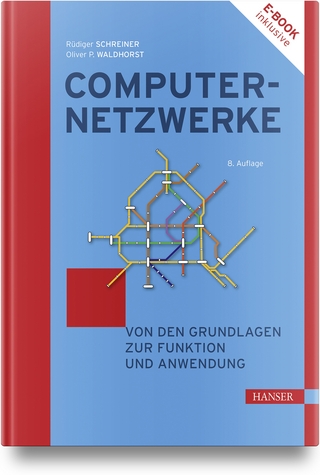
Optical Networking Best Practices Handbook
Wiley-Interscience (Verlag)
978-0-471-46052-7 (ISBN)
JOHN R. VACCA, MS, MBA, is an information technology consultant and internationally known author. He has authored more than forty books and hundreds of articles in a wide range of technologies, including telecommunications, software, intelligence systems, and networks. His book The World's 20 Greatest Unsolved Problems was named one of Amazon.com's Best Books of 2004. Mr. Vacca was also a configuration management specialist, computer specialist, and the computer security official (CSO) for NASA's space station program (Freedom) and the International Space Station Program, from 1988 until his early retirement from NASA in 1995. Additionally, he is also an Independent online book reviewer and was one of the security consultants for the MGM movie Antitrust.
Foreword xxi
Preface xxiii
Acknowledgments xxix
1 Optical Networking Fundamentals 1
1.1 Fiber Optics: A Brief History in Time 1
1.2 Distributed IP Routing 7
1.3 Scalable Communications: Integrated Optical Networks 14
1.4 Lightpath Establishment and Protection in Optical Networks 19
1.5 Optical Network Design Using Computational Intelligence Techniques 25
1.6 Distributed Optical Frame Synchronized Ring (doFSR) 26
1.7 Summary and Conclusions 29
2 Types of Optical Networking Technology 33
2.1 Use of Digital Signal Processing 36
2.2 Optical Signal Processing for Optical Packet Switching Networks 40
2.3 Next-Generation Optical Networks as a Value Creation Platform 49
2.4 Optical Network Research in the IST Program 61
2.5 Optical Networking in Optical Computing 71
2.6 Summary and Conclusions 76
3 Optical Transmitters 78
3.1 Long-Wavelength VCSELs 81
3.2 Multiwavelength Lasers 89
3.3 Summary and Conclusions 94
4 Types of Optical Fiber 95
4.1 Strands and Processes of Fiber Optics 95
4.2 The Fiber-Optic Cable Modes 95
4.3 Optical Fiber Types 97
4.4 Types of Cable Families 97
4.5 Extending Performance 98
4.6 Care, Productivity, and Choices 100
4.7 Understanding Types of Optical Fiber 101
4.8 Summary and Conclusions 106
5 Carriers' Networks 108
5.1 The Carriers' Photonic Future 108
5.2 Carriers' Optical Networking Revolution 111
5.3 Flexible Metro Optical Networks 129
5.4 Summary and Conclusions 133
6 Passive Optical Components 137
6.1 Optical Material Systems 139
6.2 Summary and Conclusions 158
7 Free-Space Optics 160
7.1 Free-Space Optical Communication 160
7.2 Corner-Cube Retroreflectors 162
7.3 Free-Space Heterochronous Imaging Reception 165
7.4 Secure Free-Space Optical Communication 168
7.5 The Minimization of Acquisition Time 170
7.6 Summary and Conclusions 175
8 Optical Formats: Synchronous Optical Network (SONET)/ Synchronous Digital Hierarchy (SDH), and Gigabit Ethernet 179
8.1 Synchronous Optical Network 179
8.2 Synchronous Digital Hierarchy 215
8.3 Gigabit Ethernet 226
8.4 Summary and Conclusions 230
9 Wave Division Multiplexing 233
9.1 Who Uses WDM? 233
9.2 Dense Wavelength Division Multiplexed Backbone Deployment 235
9.3 IP-Optical Integration 236
9.4 QoS Mechanisms 241
9.5 Optical Access Network 249
9.6 Multiple-Wavelength Sources 255
9.7 Summary and Conclusions 259
10 Basics of Optical Switching 263
10.1 Optical Switches 263
10.2 Motivation and Network Architectures 273
10.3 Rapid Advances in Dense Wavelength Division Multiplexing Technology 282
10.4 Switched Optical Backbone 291
10.5 Optical MEMS 299
10.6 Multistage Switching System 303
10.7 Dynamic Multilayer Routing Schemes 307
10.8 Summary and Conclusions 314
11 Optical Packet Switching 318
11.1 Design for Optical Networks 321
11.2 Multistage Approaches to OPS: Node Architectures for OPS 321
11.3 Summary and Conclusions 325
12 Optical Network Configurations 326
12.1 Optical Networking Configuration Flow-Through Provisioning 326
12.2 Flow-Through Provisioning at Element Management Layer 328
12.3 Flow-Through Circuit Provisioning in the Same Optical Network Domain 329
12.4 Flow-Through Circuit Provisioning in Multiple Optical Network Domain 329
12.5 Benefits of Flow-Through Provisioning 330
12.6 Testing and Measuring Optical Networks 332
12.7 Summary and Conclusions 335
13 Developing Areas in Optical Networking 337
13.1 Optical Wireless Networking High-Speed Integrated Transceivers 338
13.2 Wavelength-Switching Subsystems 344
13.3 Optical Storage Area Networks 352
13.4 Optical Contacting 362
13.5 Optical Automotive Systems 365
13.6 Optical Computing 369
13.7 Summary and Conclusions 371
14 Summary, Conclusions, and Recommendations 374
14.1 Summary 374
14.2 Conclusion 385
14.3 Recommendations 391
Appendix: Optical Ethernet Enterprise Case Study 415
A.1 Customer Profile 416
A.2 Present Mode of Operation 418
A.3 Future Mode of Operation 419
A.4 Comparing the Alternatives 421
A.5 Summary and Conclusions 423
Glossary 425
Index 453
| Erscheint lt. Verlag | 15.12.2006 |
|---|---|
| Zusatzinfo | Drawings: 120 B&W, 0 Color |
| Sprache | englisch |
| Maße | 159 x 241 mm |
| Gewicht | 839 g |
| Themenwelt | Mathematik / Informatik ► Informatik ► Netzwerke |
| Technik ► Elektrotechnik / Energietechnik | |
| ISBN-10 | 0-471-46052-4 / 0471460524 |
| ISBN-13 | 978-0-471-46052-7 / 9780471460527 |
| Zustand | Neuware |
| Haben Sie eine Frage zum Produkt? |
aus dem Bereich


